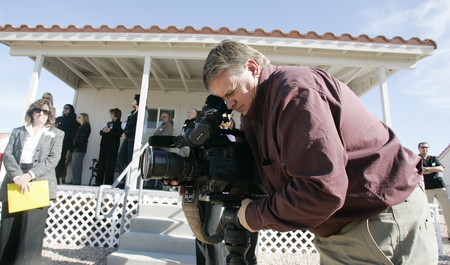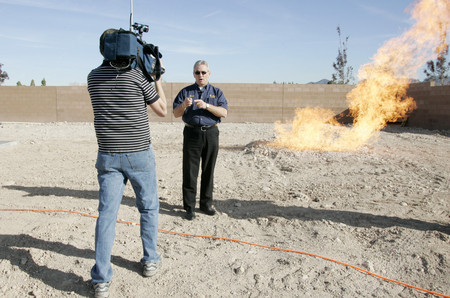Supporters of county-owned CCTV tune out critics
As four gray-haired men seated on a platform reminisce about how Las Vegas was promoted in the old days, a camera crew captures their every word and gesture.
A technician in a back room of the Clark County Commission chambers monitors the "History of Las Vegas" panel talk using a portable device with 10 small video screens.
Only a dozen people are in the auditorium on a Friday evening to see the final centennial session that CCTV-TV, Channel 4 is shooting. More viewers are expected to watch it on cable television, but exactly how many is unknown.
At a $620,000 yearly cost, the channel broadcasts commercial-free programming 24 hours a day, seven days a week, nearly all of it produced by a six-person team using mostly outdated equipment.
Critics question whether the county should be running a TV station subsidized by tax dollars, especially when county leaders plan to lay off workers.
County officials say the station's price is modest for alerting residents about issues that affect them and making government more transparent.
"Channel 4 plays an important role in disseminating information about county activities, services and programs," said county spokesman Erik Pappa, who oversees the station. "It's a great tool for accountability. People can tune in and see what's going on within county government. The good, the bad and the ugly."
Viewers have access to entire meetings that are unedited except for the rare off-color rant, he said. Examples would be the County Commission, Planning Commission, Metropolitan Police Committee on Fiscal Affairs, Regional Transportation Commission and the homelessness subcommittee.
But a conservative think tank contends that TV stations should be market-driven and not funded by taxpayers.
"Any government-run or government-funded television station is beyond the scope of what government should be charged with," said Andy Matthews, spokesman for the Nevada Policy Research Institute. "This is not in any way a commentary on the merits of the programming itself."
Pappa said the programming is what makes the station valuable to the public. Besides showing public meetings, Channel 4 imparts messages about health and safety, such as H1N1 flu prevention, and information of local interest, he said.
"County Critters" gives viewers a closer look at animal control. "Sit and be Fit" teaches low-impact exercises for seniors. The station also has shows about parks and recreation activities, cooking, transportation, Nevada women, police, the flood district, the airport and the county hospital.
Although some segments promote county services and projects that benefit taxpayers, other programs are impartial, he said. For instance, the station televises meetings for the Committee on Community Priorities, whose members often criticize the county's budget.
"We're sort of like C-SPAN for the largest local government in the state," Pappa said.
AUDIENCE NOT TRACKED
The potential audience is made up of 415,000 local cable subscribers, which means the station's cost per prospective viewer is a little more than $1 a year, Pappa said.
Actual viewership is unknown, however, because the county doesn't pay for Nielsen or other ratings, said Skip Kelley, the station's manager.
A Cox Communications executive said the company has never studied how many people watch government access channels in any part of the country.
"They're so small, I don't think anyone tracks them," said Steve Schorr, vice president of Cox Las Vegas. "I see some pretty good programming, but the viewership is so limited."
The closest yardstick is a 2003 telephone survey that the county paid for.
In a random sampling, half of the 500 residents polled said they or someone in their household had watched the channel, Pappa said. The survey didn't measure how often people watch. Viewers rated the usefulness of the information an overall 3.5 out of 5, he said.
Channel 4's operation is substantially smaller than Las Vegas' KCLV-TV, Channel 2, which employs 11 people and costs about $1.7 million yearly.
In five years, the wage and benefit portion of Channel 4's budget has grown by about 3.7 percent annually, from $475,000 in 2005 to $550,000 this year.
Some of the equipment cluttering the studio has been around as long as the 14-year-old Channel 4, making it antiquated in the digital age. In fact, studio work is done with outmoded analog cameras. Newer cameras, 7-year-old digital-tape models, are used for shooting video in the field.
Because of the county's strained budget, the station won't replace any equipment unless something breaks, even though high-definition cameras could be had for $3,000, a sixth of what the lower-tech cameras cost 10 years ago, Kelley said.
Thus, staffing is the chief expense.
SUBSIDIES RAISE QUESTIONS
This year, Kelley and two producers will receive a total of $307,000 in salaries and benefits, paid directly from the general operating fund.
McCarran International Airport pays two video technicians from its fee-generated fund, and University Medical Center pays a technician from its budget, which is partly general fund dollars. The trio will receive a total of $232,000 this year in pay and benefits to make informational videos for the airport and hospital.
The county also pays $43,000 yearly to lease a 2,500-square-foot space in the Transportation Commission's building, and spends $28,000 on supplies.
Matthews argues that no public money should be used.
Instead, he said, stations such as these should be run on private donations, either from residents or businesses.
"Let the market make those decisions, and let viewers make those decisions," Matthews said.
If no one chips in, then the demand simply wasn't there, he said.
Matthews said it's good to monitor government via television, but having the government determine what people should see is questionable.
A government access channel also can be a tool for elected leaders to keep their faces in the public's eye, creating familiarity with voters, said David Damore, political science professor at the University of Nevada, Las Vegas.
"It's one of the reasons why they (incumbents) are hard to beat," Damore said.
County policy forbids political candidates from campaigning on Channel 4. But commissioners appear regularly on the channel's "In Your Neighborhood" series in between elections.
These shows reveal a more personal side of commissioners as they discuss people, places and issues in their districts, Pappa said. A station employee interviews the commissioners. That person works with commissioners and their aides to script questions beforehand.
Damore said it's similar to congressional leaders using their postage-free privilege, known as "franking," to mail out promotional fliers. Taxpayers subsidize the lawmakers' free postal service, he noted.
Channel 4's impact is tougher to gauge than franking, "because I don't know who watches it," Damore said.
Given the scant viewership, the county should look at whether it should keep funding the station while grappling with a tight budget and impending layoffs, Damore said.
VIEWERS FIND VALUE
But Schorr doesn't foresee the "partnership" between local governments and his cable company ending, even though viewership is low.
"We know it's low ... but that doesn't mean it (government access) doesn't have value," Schorr said.
Walt Farley, 74, who attended the panel discussion on marketing Las Vegas, said he will tune in to a county meeting on Channel 4, and that's it.
"Generally I don't know what else is on there," Farley said.
In contrast, Sue Kiselovski, 62, said she and her husband enjoy watching Channel 4 because it teaches them about unique local attractions. For instance, on "County Critters" they learned about the horse-rescue ranch that Tony Curtis and his wife, Jill Vandenberg, run near Jean.
"We like stuff like that," Kiselovski said. "We never would have known about that without Channel 4."
Kelley said he is surprised at times by the station's popularity.
Viewers request DVDs of the centennial panel discussions, he said. "It's odd to me that people want DVDs. It's government access television."
It helps that Channel 4 is wedged between two popular networks on the dial, NBC and Fox, he said.
Channel-surfing viewers are more apt to spot something interesting and stop, Kelley said, adding that many people have told him that's how they discovered Channel 4.
The station fills a niche by putting out more comprehensive local information, be it a calendar of events or health tips, than TV news stations, he said.
Lisa Howfield, KVBC-TV, Channel 3's general manager, said that was true to some extent. She described her station and Channel 4 as complementary.
"Our advantage is we have higher viewership so we can get the word out to more people," Howfield said. "They have a 24/7 channel. They are able to do far more (explaining) just because they have more time to do that. I think every city should have that type of service, 24/7."
Kelley, who has worked in television since the late '70s, said Channel 4 produces everything itself except the public-service programs it airs for the state and neighboring cities.
There's no need to bring in videographers, documentary teams or other outside help, because the station's employees are talented veterans who do top-flight work with aging equipment, Kelley said. He prefers to spend money on staffers rather than gadgets.
"We have very limited funds, so let's put the resources where they can be of most use," Kelley said.
Contact reporter Scott Wyland at swyland@reviewjournal.com or 702-455-4519.
CCTV-TV, CHANNEL 4 WAGES, BENEFITS*
2009 $549,000
2008 $535,000
2007 $523,000
2006 $491,000
2005 $475,000
*Calculated by calendar years.
Source: Clark County
ON THE WEB
Channel 4


















